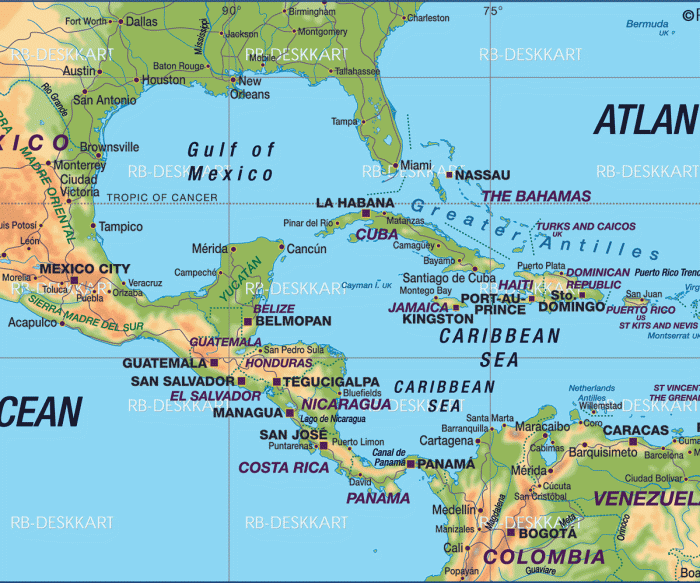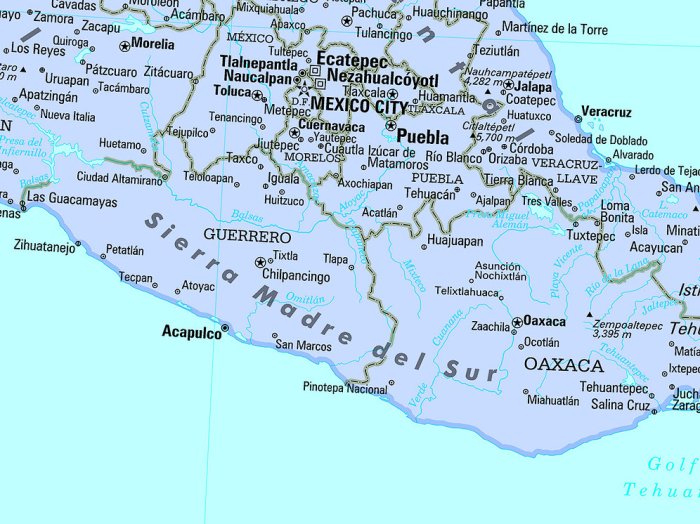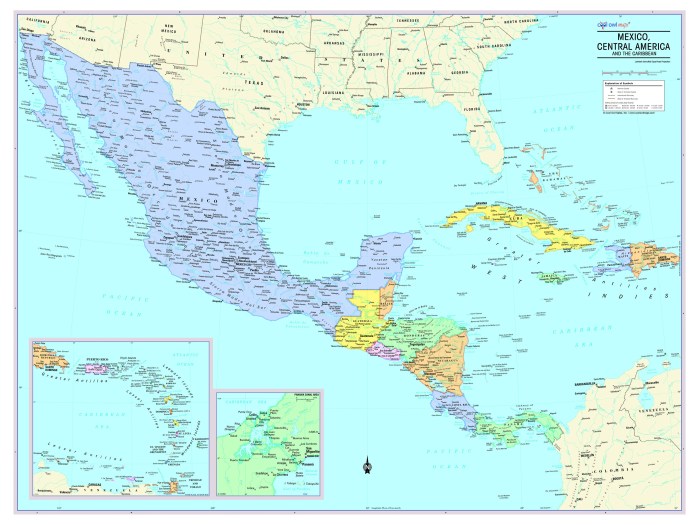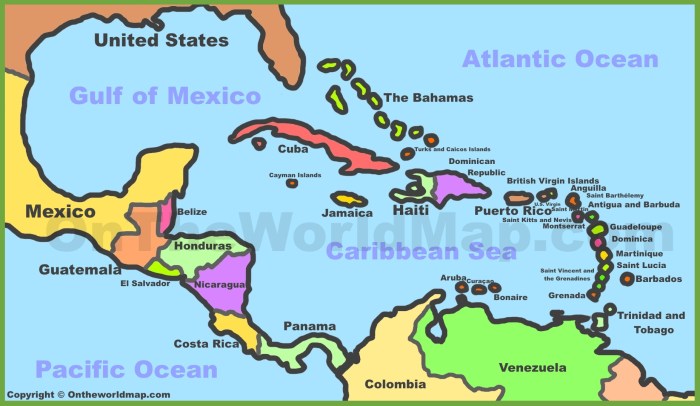Embark on a captivating journey with the Mexico and the Caribbean map, where vibrant cultures, shared histories, and breathtaking landscapes intertwine. From the azure waters of the Caribbean Sea to the towering peaks of Mexico’s Sierra Madre, this region is a tapestry of diverse ecosystems, rich traditions, and economic connections.
Our exploration begins with a comprehensive overview of the geographical features that define this captivating region, highlighting the proximity and connectivity between Mexico and the Caribbean islands. We delve into the historical ties that have shaped the region, tracing the Spanish colonial era’s profound impact and exploring the vibrant cultural exchanges and migrations that have occurred over centuries.
Geographical Overview

Mexico and the Caribbean region share a close geographical proximity and are connected by shared maritime borders and trade routes. The map below highlights key geographical features of the region, including the Gulf of Mexico, the Caribbean Sea, and the islands of the Caribbean.
Proximity and Connectivity
Mexico borders the Caribbean Sea to the east and shares maritime borders with several Caribbean nations, including Belize, Guatemala, and Cuba. This proximity has fostered close economic and cultural ties between Mexico and the Caribbean region.
Shared Maritime Borders and Trade Routes
The shared maritime borders between Mexico and the Caribbean islands have facilitated trade and transportation. The Gulf of Mexico and the Caribbean Sea serve as important trade routes for goods and services between Mexico and the Caribbean nations. These trade routes have played a significant role in the economic development of both regions.
Historical Connections: Mexico And The Caribbean Map

Mexico and the Caribbean islands share a rich and intertwined history that dates back to the era of European exploration and colonization. The arrival of Spanish conquistadors in the 16th century marked a significant turning point in the region’s history, shaping its political, economic, and cultural landscape.
Spanish Colonial Era, Mexico and the caribbean map
The Spanish colonial era left an enduring legacy on both Mexico and the Caribbean. Spain’s vast empire in the Americas included territories in present-day Mexico, Cuba, Jamaica, and many other islands in the Caribbean Sea. The Spanish imposed their political and administrative systems on these lands, establishing a hierarchical society with European settlers at the top and indigenous populations at the bottom.
The colonial period also witnessed the introduction of Catholicism, which became the dominant religion in the region. Spanish missionaries played a crucial role in converting indigenous populations and establishing churches and religious institutions throughout the Americas.
Cultural Exchanges and Migrations
The Spanish colonial era also facilitated cultural exchanges and migrations between Mexico and the Caribbean. Spanish settlers brought with them their language, customs, and traditions, which gradually blended with indigenous and African influences to create a unique cultural tapestry in the region.
Moreover, the Caribbean islands served as a gateway for the transatlantic slave trade, bringing enslaved Africans to work on plantations and in various industries. The forced migration of Africans to the Caribbean had a profound impact on the region’s demographics and cultural diversity.
If you’re planning a trip to Mexico or the Caribbean, a map can come in handy. Whether you’re exploring the ancient Mayan ruins or enjoying the pristine beaches, a map will help you navigate your way around. Speaking of exploring, if you’re interested in learning more about oral mech exams, I highly recommend checking out this oral mech exam write up . It provides a comprehensive overview of the exam, including tips on how to prepare and what to expect.
And don’t forget your map when you head to Mexico or the Caribbean!
Economic Interdependence

Mexico and the Caribbean nations share a close economic relationship characterized by trade, tourism, and investment. The proximity and historical ties between the regions have fostered significant economic interdependence.
Trade Patterns
- Mexico is a major exporter of manufactured goods, agricultural products, and oil to the Caribbean.
- The Caribbean nations primarily export tourism services, agricultural products, and minerals to Mexico.
- Free trade agreements, such as the Caribbean Basin Trade Partnership Act, have facilitated increased trade flows between the regions.
Tourism
- Mexico is a popular tourist destination for Caribbean residents, particularly for shopping and cultural experiences.
- Caribbean beaches and resorts attract a significant number of Mexican tourists.
- Tourism generates revenue and creates employment opportunities in both regions.
Investment Opportunities
- Mexico has invested heavily in tourism infrastructure, energy, and manufacturing sectors in the Caribbean.
- Caribbean nations offer investment incentives to attract foreign capital, including tax breaks and access to regional markets.
- Areas of potential growth include renewable energy, infrastructure development, and sustainable tourism.
Areas of Cooperation
- Mexico and the Caribbean collaborate on regional initiatives, such as the Association of Caribbean States, to promote economic integration.
- Cooperation also extends to disaster preparedness, environmental protection, and cultural exchange.
Cultural Influences

Mexico and the Caribbean share a rich tapestry of cultural influences that have intertwined over centuries. From the vibrant rhythms of music to the tantalizing flavors of cuisine, these two regions have profoundly impacted each other’s cultural landscapes.
Shared Musical Traditions
Music has played a central role in shaping the cultural bond between Mexico and the Caribbean. Both regions boast a diverse array of musical genres that share common roots and influences. From the soulful melodies of Mexican mariachi to the infectious beats of Caribbean reggae, these musical traditions have become an integral part of both cultures.
Culinary Delights
The culinary traditions of Mexico and the Caribbean are a testament to the region’s shared history and cultural exchange. Mexican cuisine, renowned for its use of vibrant spices and fresh ingredients, has influenced Caribbean cooking, while Caribbean flavors have found their way into Mexican dishes.
The result is a tantalizing blend of flavors that tantalizes taste buds.
Artistic Expressions
The artistic expressions of Mexico and the Caribbean reflect the region’s rich cultural heritage. Traditional crafts, vibrant textiles, and captivating dances are all shared elements that have shaped the cultural identities of both regions. These artistic forms continue to inspire and captivate audiences worldwide, showcasing the enduring power of cultural exchange.
Impact on Each Other
The cultural influences between Mexico and the Caribbean have been a two-way street. Mexican traditions have found a warm embrace in the Caribbean, while Caribbean culture has enriched the Mexican landscape. This cultural exchange has fostered a sense of unity and shared identity, creating a vibrant and diverse cultural tapestry that continues to evolve and inspire.
Environmental Considerations

Mexico and the Caribbean share a multitude of environmental challenges that require collective action. Climate change, pollution, and deforestation pose significant threats to the region’s ecosystems and sustainable development.
Impact of Climate Change
Climate change is exacerbating extreme weather events, including hurricanes, droughts, and floods. Rising sea levels threaten coastal communities and infrastructure, while changing rainfall patterns impact agriculture and water resources.
Pollution and Deforestation
Pollution from industrial activities, agriculture, and tourism contaminates air, water, and soil. Deforestation, driven by logging, agriculture, and urban expansion, contributes to habitat loss, biodiversity decline, and carbon emissions.
Collaborative Efforts
To address these challenges, Mexico and Caribbean nations have collaborated on initiatives such as the Caribbean Sea Commission and the Mesoamerican Reef Alliance. These partnerships aim to protect marine ecosystems, promote sustainable tourism, and implement climate change adaptation measures.
Questions and Answers
What are the key geographical features of the Mexico and the Caribbean region?
The region boasts diverse landscapes, including the Sierra Madre mountains in Mexico, the turquoise waters of the Caribbean Sea, and numerous islands with varying topography.
How have historical events shaped the region?
The Spanish colonial era played a significant role, leaving a lasting impact on the region’s culture, language, and political systems.
What are the major economic activities in the Mexico and the Caribbean region?
Tourism, trade, and agriculture are key economic drivers, with Mexico serving as a major trading partner for many Caribbean nations.
